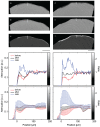Mineralization of Early Stage Carious Lesions In Vitro-A Quantitative Approach
- PMID: 29567931
- PMCID: PMC5851196
- DOI: 10.3390/dj3040111
Mineralization of Early Stage Carious Lesions In Vitro-A Quantitative Approach
Abstract
Micro computed tomography has been combined with dedicated data analysis for the in vitro quantification of sub-surface enamel lesion mineralization. Two artificial white spot lesions, generated on a human molar crown in vitro, were examined. One lesion was treated with a self-assembling peptide intended to trigger nucleation of hydroxyapatite crystals. We non-destructively determined the local X-ray attenuation within the specimens before and after treatment. The three-dimensional data was rigidly registered. Three interpolation methods, i.e., nearest neighbor, tri-linear, and tri-cubic interpolation were evaluated. The mineralization of the affected regions was quantified via joint histogram analysis, i.e., a voxel-by-voxel comparison of the tomography data before and after mineralization. After ten days incubation, the mean mineralization coefficient reached 35.5% for the peptide-treated specimen compared to 11.5% for the control. This pilot study does not give any evidence for the efficacy of peptide treatment nor allows estimating the necessary number of specimens to achieve significance, but shows a sound methodological approach on the basis of the joint histogram analysis.
Keywords: demineralization; enamel caries; image registration; joint histogram; micro computed tomography; mineralization; self-assembling peptide.
Conflict of interest statement
The authors declare no conflict of interest.
Figures



References
-
- Wefel J.S. Root caries histopathology and chemistry. Am. J. Dent. 1994;7:261–265. - PubMed
LinkOut - more resources
Full Text Sources
Other Literature Sources

